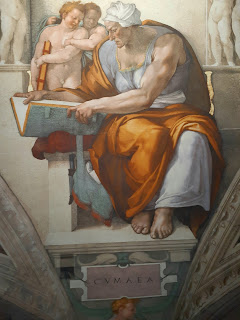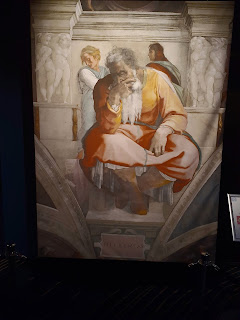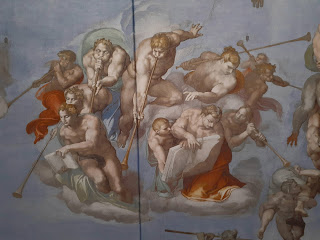When I was 15 I had the good fortune to visit the Sistine Chapel with my parents to view Michelangelo's 16th century masterpieces. I remember the occasion clearly. It was an early autumn afternoon and there was only a handful of other people there. It was peaceful and quite gloomy with shafts of light lancing through the high windows. The chapel was laid out with pews and we were able to lie on our backs along them to view the magnificent ceiling, glorious but dulled by hundreds of years of candle smoke. We were not hurried along so my parents, both art lovers and knowledgeable guides, had plenty of time to explain the frescoes to me and my brothers. The memory of that afternoon has never left me.
 |
| The Cumaean Sibyl |
Last week, here in Auckland, I went to view the touring exhibition - Michelangelo, A Different View. Using state of the art digital technology the exhibition features half sized coloured reproductions of many of the frescoes from the chapel, including the ceiling and the huge Last Judgement altarpiece. With low lighting in the gallery and only a small number of people there it reminded me of the atmosphere of my first visit to the Sistine Chapel. There was plenty of time to examine and wonder at the great works.
Left: Prophet Jeremiah
 |
The Creation of man |
At the request of Pope Julius the 2nd Michelangelo began work on the ceiling and upper part of the walls of the Sistine chapel in 1508. He chose Genesis, the beginning of the world, as the theme for the ceiling and contrary to the popular belief that he lay on his back to paint he actually painted from a standing position on scaffolding he designed himself. I can't imagine what that must have done for his neck. On the upper part of the walls he painted prophets and sibyls using a trompe l'oeil technique which makes the figures appear to be sitting on stone ledges, part of the architecture of the building.

Right: The altarpiece showing a triumphant Christ with the damned on the left and the glorious on the right
Neatly juxtaposing the ceiling's Genesis is the huge altarpiece, The Last Judgement. Commissioned by Pope Clement V11 in 1533 it contains more than 300 detailed figures. This monumental work of art portrays the second coming of Christ and the end of the world with the saved ascending into heaven and the damned being banished below. You could spend a very long time looking at this work and marveling at the variety of facial expressions Michelangelo has captured.
I am so pleased I visited this exhibition. I left feeling uplifted by the genius of Michelangelo and the opportunity to spend a leisurely amount of time enjoying a close look at what is reputed to be some of, if not the, greatest masterpieces of all time. It is unlikely that I will visit the Sistine Chapel again but I feel more than satisfied with my two visits and this wonderful opportunity to examine the frescoes in detail. Of course nothing can compare to the wonder and magnificence of an actual visit to the Sistine Chapel and this exhibition shows only a small sample of the chapel's art but it is well worth a visit all the same.
Note: My photography does not do the exhibition any justice




No comments:
Post a Comment